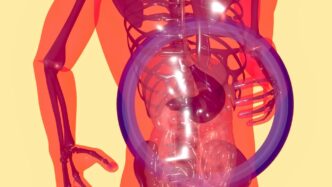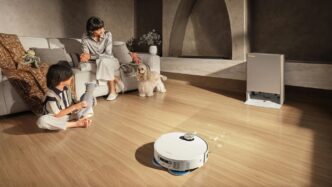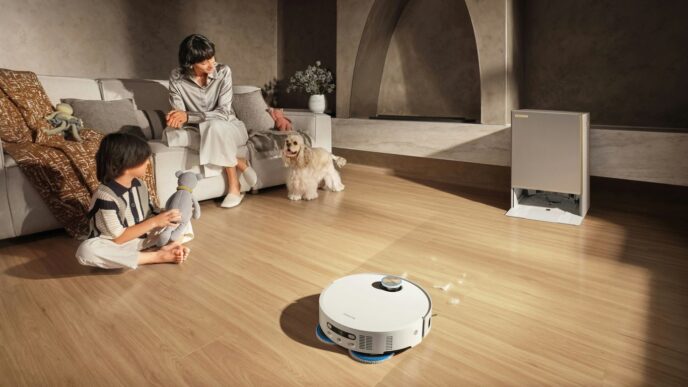The Dawn of Artificial Gestation

It sounds like something straight out of a sci-fi movie, right? Robots giving birth. But honestly, the idea of artificial wombs and machines carrying a pregnancy is moving from fiction to fact faster than you might think. China’s recent announcement about a "pregnancy robot" with an artificial womb is a huge deal, and it’s making everyone stop and think about what this could mean for how humans are made.
A Glimpse into the Future of Reproduction
So, what exactly are we talking about here? It’s basically a super advanced system designed to mimic a real human uterus. Think of a sealed chamber filled with a special fluid, like amniotic fluid, that keeps a fetus growing. It’s got tubes that act like an umbilical cord, feeding it nutrients and oxygen, and all sorts of sensors to keep track of how the baby is doing. This isn’t just about keeping premature babies alive longer; it’s about replicating the entire pregnancy journey, from the very beginning all the way to birth, outside of a human body.
The Science Behind the Pregnancy Robot
This whole concept builds on earlier work. Back in 2017, scientists managed to keep premature lamb fetuses alive and growing for weeks in something called "biobags." These were basically transparent sacs filled with artificial amniotic fluid. The lambs grew wool and seemed to develop normally. It proved that life could be supported outside a natural womb. The pregnancy robot takes that idea and runs with it, aiming for the full nine months.
Here’s a quick look at how it’s envisioned:
- Gestation Chamber: A controlled environment simulating the uterus.
- Nutrient & Oxygen Supply: A system mimicking the umbilical cord.
- Monitoring Systems: Advanced sensors to track fetal development.
- Delivery Mechanism: A way to safely deliver the baby at term.
From Biobags to Humanoid Gestation
While the "biobag" experiments were groundbreaking, they were more about supporting premature life. The new goal is to handle the entire gestation period. Some researchers are even talking about robots that could "bond" with the fetus by playing sounds like a mother’s heartbeat or voice. The idea is to create a complete, uninterrupted gestation cycle managed by technology. It’s a massive leap from those early experiments to a fully functional "pregnancy robot."
Addressing Global Infertility and Health Concerns
It’s easy to get caught up in the futuristic "wow" factor of robots gestating babies, but behind the headlines, there’s a really human story unfolding. For so many couples, the dream of having a child feels out of reach. We’re talking about infertility, which is a surprisingly common issue. Globally, around 15% of couples struggle with it, and in places like China, those numbers have been climbing pretty steadily. Think about it: years of trying, expensive treatments, maybe even failed attempts at surrogacy – it’s a tough road.
A Solution for Couples Facing Infertility
This is where the idea of a pregnancy robot, or more accurately, an artificial womb system, really starts to make sense. It’s not just about novelty; it’s about offering a real chance at parenthood to people who might otherwise never experience it. And let’s be honest, cost is a huge factor. Traditional surrogacy can run into the tens of thousands, sometimes over a hundred thousand dollars when all is said and done. Early projections for these artificial gestation systems are a fraction of that. For families who have already poured their savings into fertility treatments, this could be a game-changer, a way to finally build the family they’ve always wanted.
Reducing Risks Associated with Maternal Mortality
But it’s not just about infertility. Pregnancy itself, while a miracle, isn’t without its dangers. Globally, complications during pregnancy and childbirth still claim far too many lives each year, especially in areas with less developed healthcare. Conditions like preeclampsia or severe bleeding are serious threats. If artificial wombs can take on the physical burden of carrying a pregnancy, removing some of those risks from the mother’s body, it could genuinely save lives. It’s a way to rethink reproductive health and make it safer.
Potential for Assisting Premature Infants
And there’s another angle: premature babies. Right now, the technology is likely to be used first to help very premature infants. Imagine a system that can provide a stable, controlled environment for a baby born too early, mimicking the womb’s conditions outside the body. This could give these fragile newborns a much better chance at survival and healthy development. It’s a stepping stone, a way to refine the technology before it’s even considered for full-term gestation. The goal is to improve outcomes for the most vulnerable babies, offering them a better start in life.
The Ethical Landscape of Robotic Birth

Okay, so we’ve talked about the cool science and the potential benefits of robots carrying babies. But let’s get real for a second. This whole idea brings up some pretty heavy questions, and honestly, it’s a bit unsettling when you really think about it.
Dehumanization of Childbirth and Maternal Bonds
First off, there’s the whole "dehumanization" thing. Critics worry that if we start outsourcing pregnancy to machines, we might lose something really important about what it means to be a mother. It’s not just about growing a baby; it’s about hormones, those weird cravings, the kicks, the whole nine months of connection. Can a robot, no matter how fancy, replicate the feeling of a baby moving inside you, or the rush of oxytocin when you finally hold your newborn? Some people, like feminist writer Andrea Dworkin, have warned that this could lead to women being devalued, their role in family and culture diminished because a machine can now do the biological heavy lifting. It’s like treating pregnancy as a problem to be solved with engineering, rather than a natural, albeit challenging, human experience.
Concerns Over Designer Babies and Social Inequalities
Then there’s the "designer baby" worry. If we’re already talking about artificial wombs, it’s not a huge leap to imagine parents wanting to pick and choose traits for their kids. We’re not just talking about preventing diseases, but maybe selecting for intelligence, looks, or athletic ability. This could create a huge divide in society. Imagine a world where only the wealthy can afford to "optimize" their children, leading to a genetic class system. It’s a slippery slope, and the idea of a marketplace for human traits is pretty disturbing.
Cultural and Religious Opposition to Mechanized Gestation
And of course, you can’t talk about something this big without mentioning cultural and religious viewpoints. For many, life begins at conception, and the idea of a machine playing a role in that process goes against deeply held beliefs. It challenges traditions and the very definition of family and creation that have been around for centuries. While IVF faced similar pushback initially, it largely worked with natural processes. Robotic gestation, on the other hand, aims to replace a core human experience, which is a much bigger hurdle for many faiths and cultures to accept. It forces us to ask what we value most: efficiency and technological advancement, or the traditional, intimate journey of bringing new life into the world.
Redefining Parenthood in the Age of Robots
So, we’re talking about robots carrying babies. It’s a lot to wrap your head around, right? This whole idea of artificial gestation really makes you stop and think about what it even means to be a parent. For ages, motherhood has been tied to the physical act of carrying a child, the whole nine months of pregnancy. But if a machine can do that, who is the ‘mother’? Is it the person who provides the egg and sperm? Is it the scientist who programmed the robot? Or maybe the person who decides to raise the child? These questions aren’t just philosophical; they’re going to shape how we define family and our deepest human connections.
Who Becomes the ‘Mother’ in Robotic Gestation?
This is the big one. If a robot handles the pregnancy, the traditional biological link is broken. We’re used to thinking of the mother as the one who experiences pregnancy, the physical changes, the kicks, the connection that builds over months. With artificial wombs, that experience is gone. So, does ‘motherhood’ become more about the intention and the care provided after birth? We might see a shift where the role of ‘mother’ is defined by legal and social commitment rather than biological process. It could mean that anyone, regardless of gender or biological capability, could be a parent in the same way.
Liberation Through Technology or Devaluation of Motherhood?
On one hand, this technology could be incredibly liberating. Think about women who face severe health risks during pregnancy, or those who simply can’t carry a child for medical reasons. This could open up parenthood to so many more people, removing a huge physical barrier. It could mean fewer maternal deaths and more families formed. But then there’s the other side. Some worry that if we outsource gestation, we might start to see motherhood itself as less important, or even obsolete. It’s like saying the physical act of creation isn’t as valuable as the planning or the upbringing. Could this lead to a society that values efficiency over the messy, beautiful, and sometimes difficult reality of human pregnancy and birth?
Shifting Family Structures and Societal Norms
Imagine a future where family structures look really different. Maybe we’ll see more intentional families, where people choose parenthood through a technological process rather than solely through biological means. This could challenge our current ideas about lineage and inheritance. It might also change how we view the parent-child bond. If the initial stages of life are managed by a machine, how does that affect the emotional connection that forms? We’re talking about a fundamental change in how life begins, and that’s bound to ripple through every aspect of society, from legal definitions of parentage to the very stories we tell ourselves about what it means to create and raise a human being.
The Global Race for Reproductive Innovation
It feels like every week there’s a new headline about some country making a big leap in artificial wombs or pregnancy robots. It’s not just a few labs tinkering anymore; it’s turning into a real competition. Countries are pouring money and research into this, and honestly, it makes sense. Whoever cracks this first could really shape the future of how we have families.
China’s Leading Role in Pregnancy Robot Development
China seems to be out in front, at least in terms of public announcements. They’ve been talking about pregnancy robots and artificial wombs for a while now. It’s not just about the tech itself, but also about addressing their own falling birth rates. They’ve seen a big jump in infertility, going from around 12% of couples struggling to have kids a decade ago to nearly 18% recently. So, this isn’t just a futuristic experiment for them; it’s a potential solution to a real demographic problem. Their prototypes, like the ones Kaiwa Technology has shown, are also looking way cheaper than traditional surrogacy, which could open doors for so many more people.
International Efforts in Artificial Womb Technology
But China isn’t the only player. The US has seen some success, with researchers keeping lamb fetuses alive for extended periods in artificial environments. They’re looking at how to scale that up for human use. Japan is also exploring ex-utero gestation systems, partly to combat their own low birth rates. Even Israel has had success growing mouse embryos in artificial wombs for several days. It’s like a new kind of arms race, but instead of weapons, nations are competing to control the future of having babies.
Here’s a quick look at some of the activity:
- United States: Focus on sustaining premature fetuses and scaling technology for human application.
- Japan: Researching artificial gestation to address declining birth rates.
- Israel: Early-stage success with growing mammalian embryos in artificial wombs.
The Future of Human Reproduction and Biotech
This whole push for artificial gestation is more than just a scientific race; it’s forcing us to think about what reproduction even means. The technology is advancing so fast that it’s no longer a question of if we can do this, but when and how we’ll integrate it into our lives. It’s a massive biotech development that could change everything from family planning to global health. We’re talking about potentially saving lives by reducing the risks of pregnancy and childbirth, which still tragically claim hundreds of thousands of women’s lives each year. But it also brings up a whole new set of questions about ethics, society, and what it means to be human. It’s a wild ride, and it’s only just beginning.
Navigating the Legal and Societal Implications
So, we’ve got these robots that could potentially carry a baby. It sounds wild, right? But it brings up a whole bunch of questions that aren’t just about the tech itself. Think about the laws. Our current rules about who’s a parent, who gets custody, and even who inherits what are all built around the idea of a human mother giving birth. What happens when a machine is in the middle of all that? It’s a total legal puzzle.
Legal Gray Areas in Robotic Parenthood
This is where things get really murky. If a robot gestates a child, who’s the legal parent? Is it the person who owns the robot? The one who provided the genetic material? Or maybe the company that built the machine? We don’t have clear answers for this yet. It’s like trying to fit a square peg into a round hole. We’re talking about a whole new category of "parent" that doesn’t fit into our old boxes. It’s not just about who gets the baby; it’s about responsibility, rights, and even things like taxes and social security. The legal system is going to have to do some serious catching up.
Transforming Societal Narratives of Life Creation
For ages, the story of creating life has been deeply personal, tied to human connection, love, and sometimes, a lot of struggle. Now, imagine that story changing. If we can outsource pregnancy to a machine, what does that do to our understanding of family and motherhood? Some people see it as a way to overcome infertility or health risks, which is great. But others worry it could make childbirth seem less special, or even devalue the role of mothers. It’s a big shift in how we think about where we come from and how families are made. It could change everything from wedding vows to how we talk about our origins.
Upholding Values in a New Era of Reproduction
As this technology develops, we’re going to be faced with some tough choices. Do we embrace it fully, or do we put limits on it? What values do we want to carry forward into this new age of reproduction? We need to think about things like:
- Fairness: Will this technology be available to everyone, or will it create a divide between those who can afford it and those who can’t?
- Human Connection: How do we make sure that even with advanced technology, the emotional bonds that are so important in raising a child aren’t lost?
- Ethics: What are the long-term consequences of separating the act of gestation from the human body? Are there things we shouldn’t be doing, even if we can?
It’s not just about building better robots; it’s about deciding what kind of society we want to be as we build them.
A New Dawn, or a Dangerous Detour?
So, the idea of a robot giving birth might sound pretty wild, even a little scary. But it really just shows how humans are always pushing to see what’s next. We’ve gone from figuring out fire to flying in space, and each step makes us think hard about using our new powers wisely. This pregnancy robot is no different. It’s not just a cool piece of tech; it’s like a mirror showing us what we value. When we think about creating life, what really matters to us? The answer to that will decide if this is a step forward or a wrong turn.














